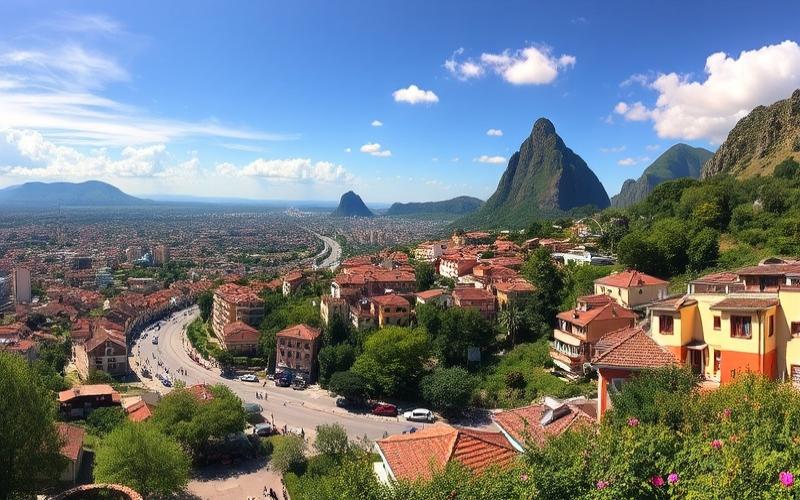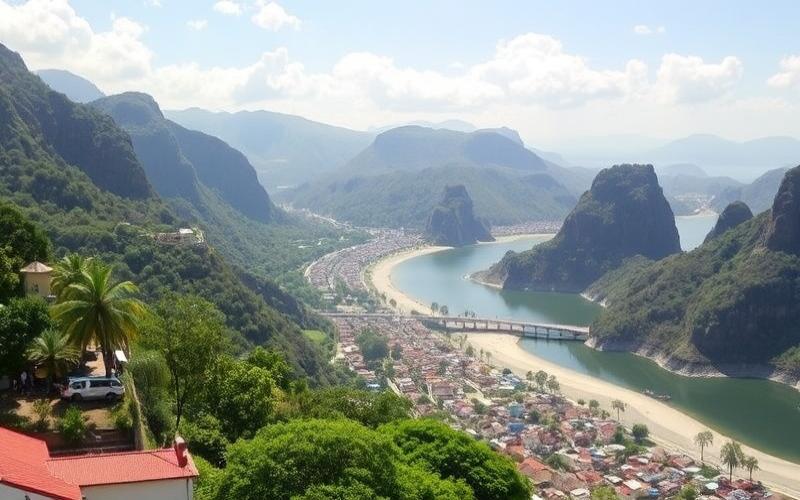
 Published on and written by Cyril Jarnias
Published on and written by Cyril Jarnias
The Impact of the War in Ukraine on Brazilian Real Estate
The impact of the war in Ukraine extends far beyond European borders, reshaping the contours of many economic sectors worldwide, including Brazil’s real estate market. As the conflict continues to disrupt global supply chains and cause fluctuations in commodity markets, Brazilian investors are reevaluating their investment strategies in the face of these new economic realities.
From increased construction material costs to slowed development projects, the impact is palpable, pushing local players to navigate an uncertain landscape and adapt their approach to safeguard their real estate portfolios while seeking new growth opportunities in an unpredictable context.
Good to know:
Fluctuations in commodity prices like steel and cement have a direct impact on construction costs, which can delay or make certain real estate projects in Brazil less profitable.
Ukrainian Crisis: Repercussions on the Brazilian Real Estate Market
The repercussions of the Ukrainian crisis on the Brazilian real estate market manifest through interdependent economic channels—exchange rates, commodities, and economic policies—that modulate the cost of capital, demand, and investor risk perception. The essentials: increased geopolitical uncertainty, imported inflationary pressure, prolonged monetary tightening, and capital reallocation, with heterogeneous effects across segments (logistics, rental residential, high-end).
Exchange Rate Fluctuations
- Temporary depreciation of the real during peaks of geopolitical risk, fueled by global risk aversion, increases the cost of imported construction inputs (steel, equipment, construction technologies), squeezing developers’ margins and increasing asset replacement costs.
- Exchange rate volatility increases the risk premium demanded by foreign and local investors, especially for projects with long cash flows and financing sensitivity, which can delay launches and reduce appetite for Core-Plus and Value-Add segments.
- Temporary appreciations linked to terms of trade (high commodities) support the real and mitigate imported costs, but reinforce cyclicality: capex and construction planning must incorporate exchange buffers and indexation clauses.
Impact on Commodities
- Shocks to energy and global inputs (steel, aluminum, fertilizers, diesel) raise construction costs, prolong execution timelines, and intensify contract renegotiations between developers and contractors.
- Brazil, a net exporter of certain commodities (soybeans, oil, iron ore), benefits from an income effect that supports certain regions (port logistics, warehouses, agribusiness hubs), but transmission to residential is uneven: sectoral income increases vs. higher construction costs.
- Rising material prices push developers to reconfigure products: more compact units, more modular construction phases, increased use of substitute materials and prefabrication.
Economic Policy Changes
- More restrictive and prolonged monetary policy to anchor imported inflation expectations, maintaining high real rates that weigh on real estate credit accessibility and increase required cap rates.
- Targeted fiscal and parafiscal policies to cushion the shock (social housing subsidies, construction credit lines, credit guarantees), supporting entry-level segments, but with execution and targeting constraints.
- Regulatory adjustments in real estate financing (securitization, indexed CRI/CRI, interest rate and exchange rate hedges) to diversify capital sources and reduce dependence on traditional bank credit.
Transmission to the Real Estate Sector
Cost of Capital and Valuations
- Increase in discount rates and widening of credit spreads, especially for highly leveraged developers.
- Repricing of Core assets with moderately rising cap rates; stronger selectivity on Value-Add requiring high capex.
Demand and Volumes
- Slowdown in sales in financing-sensitive segments, increased cancellations when purchasing power is eroded by inflation and credit costs.
- Relative resilience of institutional rental (multifamily build-to-rent, self-storage, urban logistics) driven by indexed revenues and structural demand.
Construction and Pipeline
- Extended timelines, EPC renegotiations, prioritization of projects with shorter cycles and rapid cash conversion.
- More attention to asset energy efficiency to reduce exposure to energy costs and capture “green” premiums.
Investor Confidence and Buying/Selling Trends
- Geopolitical uncertainties increase demand for assets perceived as defensive: long indexed leases, investment-grade tenants, prime assets in regional capitals.
- Foreign investors reallocate to markets deemed more predictable or to liquid asset classes; in Brazil, this translates into longer due diligence, stricter covenants, and entry discounts.
- For households, housing maintains an inflation hedging function, but solvency is constrained by credit costs; purchases shift towards lower price points, well-connected suburbs, and projects with payment facilities.
Brazilian Market Reactions to Geopolitical Uncertainties
- Rescheduling of launches, project phasing, and portfolio arbitrage towards resilient segments (logistics linked to e-commerce and agribusiness, residential rental, well-located Class A corporate offices with strong ESG).
- Strengthening of rent indexation and cost adjustment clauses in construction contracts.
- Increased use of interest rate (swaps, caps) and exchange rate hedges, and diversification of financing via CRIs/LCIs, joint-ventures club deals, and partnerships with insurers and pension funds.
Mitigation Strategies Employed by Local Players
Financing
- Mix of fixed/variable rate debt with duration ladder and prudent refinancing triggers.
- Securitization of future revenues and off-balance vehicles to reduce consolidated leverage.
Purchasing and Construction
- Supply contracts with price caps, commodity hedging (steel, fuel) when available, and bulk purchasing schedules.
- Standardization, prefabrication, BIM to reduce waste and delays; “value engineering” design to preserve margins.
Product and Marketing
- Portfolios oriented towards assets with indexed cash flows, usage flexibility (urban logistics, mixed-use assets).
- Commercial offerings with transparent indexation, staggered payments, and additional services that improve tenant retention.
Governance and Risk
- Geopolitical scenarios integrated into risk management (interest rate/FX stress tests, commodity assumptions).
- ESG and energy efficiency to reduce opex and capture institutional investor demand.
Table – Macro-Financial Effects and Real Estate Implications in Brazil
| Channel | Mechanism Influenced by the Crisis | Macro Effect in Brazil | Direct Real Estate Impact | Typical Market Response |
|---|---|---|---|---|
| Exchange Rate | Risk Aversion, Flight to Safety | Real Volatility, Risk Premiums | Higher Imported Costs and WACC | FX Hedging, Indexation Clauses |
| Commodities | Energy, Steel, Logistics | Input Inflation, Delays | Rising Capex, Margin Pressure | Bulk Purchasing, Material Substitution |
| Monetary Policy | Fighting Imported Inflation | Higher Rates for Longer | Rising Cap Rates, Constrained Demand | Mixed Debt, CRI/LCI Financing |
| Fiscal Policy | Targeted Housing Measures | Partial Support for Social Segments | Stabilizes Entry-Level Volumes | Subsidies, Credit Guarantees |
| Confidence/Investors | Geopolitical Uncertainty | Capital Reallocation | Stricter Due Diligence, Discounts | Focus on Defensive Indexed Assets |
Points to Monitor Going Forward
- Sensitivity of cap rates to a monetary pivot: possible compression if sustained disinflation, but dependent on global risk appetite.
- Trajectory of energy and logistics costs: decisive for construction viability and appeal of green assets.
- Housing policy and credit instruments: ability to preserve affordability will condition residential volumes.
The shocks from the Ukrainian crisis transmit to Brazil via exchange rates, inputs, and monetary policy, increasing the cost of capital and reconfiguring demand; players who secure their costs, diversify their financing, and prioritize indexed and energy-efficient assets best mitigate these effects.
Good to know:
The Ukrainian crisis has notable repercussions on the Brazilian real estate market, primarily due to exchange rate fluctuations and the impact on commodities. The war exacerbates global economic uncertainty, which has led to an increase in exchange rates, making real estate investments more expensive for foreign buyers. At the same time, rising commodity prices, such as wheat and energy, lead to increased inflation in Brazil, impacting consumer purchasing power and slowing the construction sector due to high material costs. Investors, faced with this instability, are adopting a cautious approach, resulting in a slight drop in real estate demand. Local players, however, are seeking to mitigate these effects by adopting strategies such as investment diversification and optimization of available resources, while closely monitoring economic policies that could more directly influence the market in the current international context.
Ukrainian Refugees and the Housing Challenge in Brazil
Ukrainian refugees have chosen Brazil due to a combination of factors: relaxed welcoming policies offering humanitarian stay pathways, a recent tradition of asylum and resettlement, and the presence of an NGO/UN ecosystem already mobilized for other nationalities, which facilitated orientation, registration, and access to basic services. Brazil hosts over 731,000 people in need of protection (primarily Venezuelans), and explicitly includes Ukrainians in its legal stay and integration mechanisms, which has helped attract a portion of those displaced outside Europe. Meanwhile, the Ukrainian crisis remains global (over 6.8 million refugees registered worldwide by early 2025), multiplying extra-European routes for a fraction of families seeking sustainable alternatives.
- Reasons for Attractiveness:
- Special stay procedures for nationalities affected by humanitarian crises, including Ukrainians, with operational support from UNHCR for access to protection and integration.
- Brazilian institutional capacity strengthened since 2018-2023 by managing other flows (Venezuela, Haiti, Afghanistan), creating replicable reception desks and networks for Ukrainians.
- Global context of mass displacement, pushing some households to seek destinations outside Europe saturated with accommodation.
Housing Challenges for Ukrainian Refugees in Brazil
The housing challenges for Ukrainian refugees in Brazil are concentrated in large metropolises (São Paulo, Curitiba, Porto Alegre, Rio de Janeiro), where affordable supply is insufficient and competition is high:
- Availability and Accessibility:
- Structural tension in the urban popular rental stock, with waiting lists and entry barriers (security deposit, guarantor) for households without credit history or recent formalized income.
- Inequalities in access to information, documentation, and formal work delaying residential stabilization, despite often high but low-wage employment rates observed among refugees in the regional context.
- Concentration of demand in neighborhoods close to informal employment and services, saturating studio and 1-2 bedroom segments.
Impact on the Local Real Estate Market
- Increased pressure on rents in the low and lower-middle price segments of large cities with high arrival of protected persons, reinforcing competition with other low-income households.
- Occasional community tensions around access to rent assistance and temporary shelters, especially where municipal capacities are already strained by other flows (notably Venezuelans).
- Rapid increase in the total number of people under protection during 2023-2024, intensifying needs for rental solutions and bridges to the private market.
Housing Support Initiatives
Mechanisms and Actors
- UNHCR and municipal/state partners: orientation, legal information, rental mediation, integration assistance, and intranational transfers to cities with better reception capacity.
- Local and faith-based networks: emergency shelter, community sponsorship, and support for lease search (guarantors, deposit negotiation).
- Interagency Ukraine Coordination: monitoring economic vulnerabilities and promoting job access as a lever for housing solvency.
Types of Support
- Temporary shelters and transition solutions for new arrivals.
- Occasional rent assistance, housing vouchers, and administrative support for documents and bank account opening, facilitating lease signing.
- Intra-country resettlement programs to bring employment and available housing closer.
Prospects and Possible Solutions
Increasing Affordable Rental Supply
- Mobilize vacant stock through tax incentives for owners and public/NGO rental guarantees for households without credit history.
- Public-private partnerships for social co-living and conversion of underused buildings into transitional housing, with capped duration and rents.
Reducing Access Barriers
- Deploy rental guarantee funds and rent default insurance dedicated to refugees, conditional on employment-training support.
- Simplify and accelerate documentation and diploma validation to increase access to formal employment, improving rent payment capacity.
Improving Territorial Distribution
- “Matching” mechanisms between cities with low vacancy/high rents and medium-sized cities with reception capacity, leveraging transfer programs already practiced with other nationalities.
- Incentives for settlement outside hyper-centers, with transport/installation subsidies and targeted information on local markets.
Strengthening Coordination and Monitoring
- Housing-employment dashboards to anticipate demand peaks and adjust assistance.
- Consultation frameworks between municipalities, UNHCR, and civil society to standardize rental mediation and share best practices.
Funding and Sustainability
- Channel international funds dedicated to the integration of Ukrainian displaced persons towards evidence-based housing solutions, linked to economic integration and housing retention indicators.
- Integrate Ukrainian households into Brazilian social housing and inclusive urban planning policies, to avoid creating pockets of precarious housing.
Useful Quantitative Reference Points
- Total number of people under protection in Brazil: over 731,000 (2024), with mechanisms also covering Ukrainians.
- Strong recent increase in the stock of recognized refugees/people in need of protection, increasing needs for affordable urban housing.
- Persistent economic vulnerability of refugees in the regional context, despite gradual labor market insertion, implying a risk of residential precarity without targeted support.
Good to know:
Ukrainian refugees have chosen Brazil due to its humanitarian welcoming policies, facilitated by special visas and a simplified asylum process. However, they face housing challenges, particularly in large cities like São Paulo and Rio de Janeiro, where supply is limited and rents are high. This influx increases pressure on the real estate market, raising prices and exacerbating tensions in some communities. To address these challenges, initiatives like those from UNHCR and local NGOs offer housing and social integration support. In the future, Brazil could consider solutions such as building social housing and integrating refugees into urban development plans to improve their situation.
Geopolitics and Real Estate Investment Strategies in Brazil
International geopolitical tensions, particularly the war in Ukraine, have redirected global investment flows towards assets and jurisdictions perceived as more resilient, while tightening compliance and controls on capital linked to Russia. This recomposition, combined with imported energy volatility in Europe, has reinforced the relative appeal of emerging markets offering yield and macro-fiscal stability, from which Brazil benefits through its market depth, diversified energy base, and competitive real estate taxation for non-residents.
Main Impact Mechanisms
- Recanalization of capital: withdrawal or freezing of Russian investors in Europe, opening space for other nationalities and sectoral redeployment towards markets not exposed to sanctions.
- Regional risk premium in Europe: increased financing costs and heightened caution, encouraging geographical diversification towards Latin America, including Brazil.
- Brazilian comparative fiscal advantage: fixed-rate capital gains taxation for non-residents and moderate transaction costs supporting net after-tax profitability.
Brazil’s Economic and Diplomatic Relations with Europe and Russia: Implications for Allocation
- With Europe: sanctions against Russian nationals and enhanced compliance have reconfigured demand in certain European segments, favoring diversification outside the EU; Brazil captures part of this reallocation thanks to its size, urban liquidity (São Paulo, Rio, Belo Horizonte), and fiscal framework.
- With Russia: strict non-alignment diplomatic posture and maintenance of trade ties (fertilizers, energy) reduce direct exposure to sanctions, while maintaining access to international capital through market depth and European/American anchors via multinationals operating in Brazil.
- Strategic consequence: yield/perceived risk arbitrage in favor of Brazil for investors seeking partial decorrelation from European risk and a readable tax regime.
Energy Markets and Real Estate: Transmission to Costs and Profitability
The gas and oil shock linked to the conflict has increased energy costs in Europe, indirectly affecting global material chains (steel, cement, glass), resulting in higher construction costs and margin pressure on CAPEX-intensive projects. Investors arbitrate in favor of markets where energy and inputs are less indexed to European imports, a relative advantage for Brazil.
The Brazilian fiscal differential partially cushions cost inflation by improving after-tax IRR, notably through capital gains taxation for non-residents and an overall competitive tax burden.
Recent Data and Real Estate FDI Dynamics in Brazil
- Attractive tax framework for non-residents (fixed rate on capital gains, overall charges lower than many European countries) supports the inflow of FDI oriented towards institutional rental residential, urban logistics, and prime offices in large metropolises.
- Marginally, the withdrawal of some Russian clientele in Europe has redeployed flows to other jurisdictions, reinforcing competition for core assets in large emerging markets, including Brazil.
- Managers intensify compliance due diligence and local acquisition structures to secure bankability and access to financing in reais.
Political and Economic Risk Mitigation Strategies
- Intra-Brazil geographical diversification: mix between Southeast (São Paulo, Rio), tourist Northeast, and secondary capitals to smooth local cycles.
- Contractual indexation: rents indexed to local inflation indices and commodity adjustment clauses for EPC when possible.
- Exchange rate hedging: BRL hedging via NDF or natural local debt to limit erosion of returns in strong currencies.
- Disbursement sequencing: project phasing, cost escalation clauses, and CAPEX contingency buffers to absorb input volatility.
- Governance and compliance: enhanced KYC, screening of counterparts exposed to sanctions, structuring via compliant local vehicles.
- Taxation and structuring: optimization via Brazilian regimes favorable to non-residents to maximize after-tax yield.
- Sector orientation: prioritization of logistics assets, institutional multifamily residential, and data centers less sensitive to tourist cycles, with long-term leases.
Table — Geopolitical Effects and Implications for Real Estate Investment in Brazil
| Geopolitical Factor | Transmission Channel | Effect in Brazil | Investment Response |
|---|---|---|---|
| War in Ukraine | Sanctions, Withdrawal of Russian Buyers in Europe | Diversification of Flows to Emerging Markets | Rebalance Allocation to Brazil Core and Value-Add |
| Energy Shock | Increased Material/Transport Costs | CAPEX Pressure, Delays | CAPEX Buffers, Escalation Clauses, Local Sourcing |
| Compliance Tightening | KYC, Targeted Asset Freezes | Slower but Safer Processes | Strengthen Due Diligence and Local Structuring |
| Brazilian Fiscal Advantage | Fixed Capital Gains Rate for Non-Resident | Improved After-Tax IRR | Prioritize Exits via Asset Sales |
Points to Monitor for 2025
- Sensitivity of financing spreads to new waves of geopolitical volatility in Europe.
- Monitoring input costs (steel, cement) and logistics availability; prioritize contracts with maximum guaranteed prices when possible.
- Europe vs. Latin America arbitrages influenced by persistence of sanctions and energy trajectory; Brazil remains fiscally competitive.
Operational Checklist
- Calibrate pipeline with +10/+20% cost scenarios and IRR sensitivity tests.
- Hedge 50–80% of BRL exposure over 12–24 months for core assets.
- Pre-negotiate energy pass-through clauses on logistics leases.
- Establish a geopolitical risk and counterparty compliance committee.
- Use local debt for natural hedging and faster access to disbursements.
- Prioritize cities with rental depth (São Paulo, Rio) and phased delivery projects.
Key takeaway: the repositioning of capital post-Ukraine, European energy volatility, and enhanced compliance elevate Brazil’s relative premium, where the combination of market depth + competitive taxation helps preserve real estate profitability, subject to active management of costs and exchange rate risk.
Good to know:
International geopolitical tensions, amplified by the war in Ukraine, have a direct impact on real estate investment strategies in Brazil. Fluctuations in energy markets, caused by the conflict, increase construction costs, affecting the profitability of real estate projects. Brazil, despite a complex relationship with Europe and Russia, remains a preferred destination for foreign direct investment (FDI), although these experience variations depending on global uncertainties. Investors adopt diversified strategies, such as supporting sustainable projects or integrating innovative technologies to mitigate political risks. Some companies also favor local partnerships to more easily access the market and mitigate the effects of global economic fluctuations on their investments.
Disclaimer: The information provided on this website is for informational purposes only and does not constitute financial, legal, or professional advice. We encourage you to consult qualified experts before making any investment, real estate, or expatriation decisions. Although we strive to maintain up-to-date and accurate information, we do not guarantee the completeness, accuracy, or timeliness of the proposed content. As investment and expatriation involve risks, we disclaim any liability for potential losses or damages arising from the use of this site. Your use of this site confirms your acceptance of these terms and your understanding of the associated risks.






















































